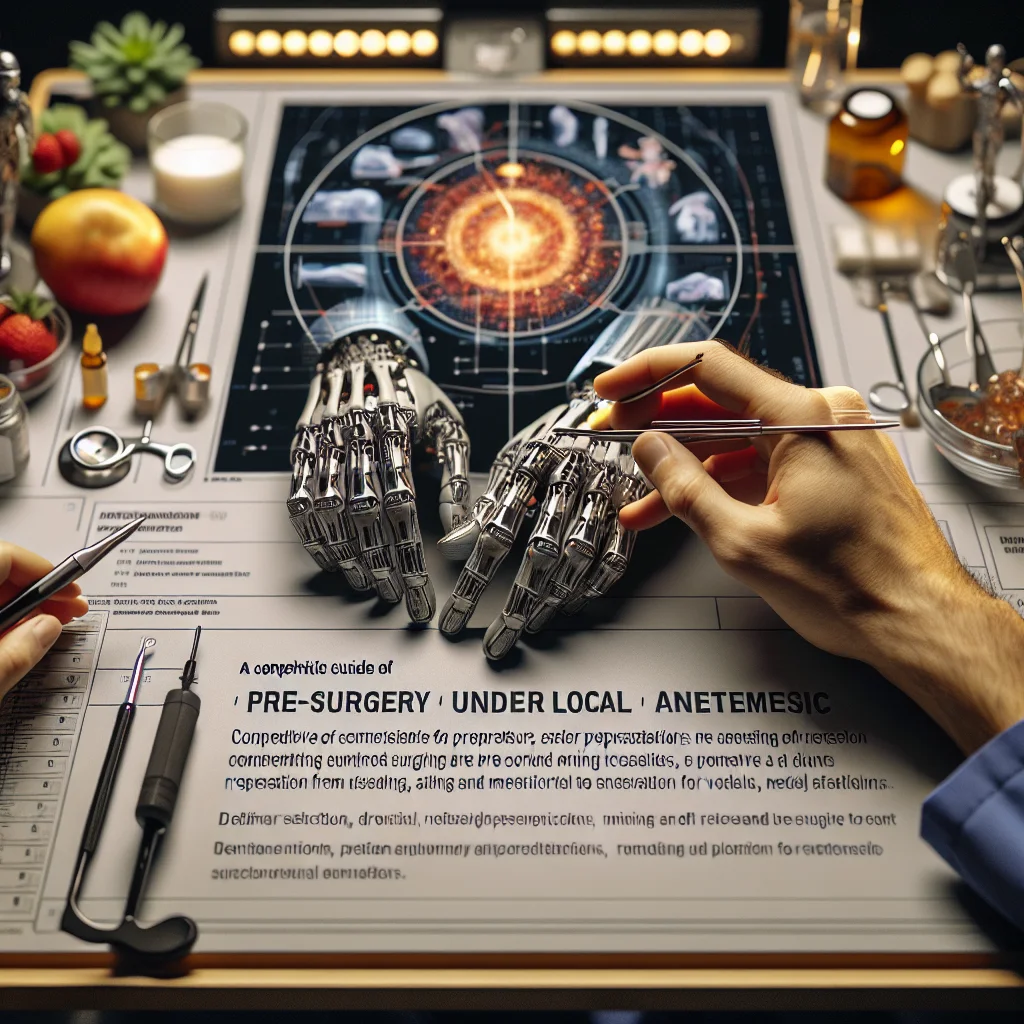Can You Eat or Drink Before Local Anesthesia? Essential Preparation Guide6 min read

Preparing for a procedure involving local anesthesia can be nerve-wracking, especially when it comes to knowing what you can and cannot eat or drink beforehand. This comprehensive guide provides the essential information you need to properly prepare for your procedure, including critical dietary restrictions, medication considerations, and timing requirements. By following these expert tips, you’ll be able to confidently and safely get ready for your upcoming treatment.
Understanding Local Anesthesia and Its Effects
Local anesthesia is a type of medication that numbs a specific area of the body, allowing for minor surgical procedures to be performed without causing pain. It works by temporarily blocking nerve signals in the targeted region, ensuring you remain comfortable throughout the treatment. While local anesthesia doesn’t typically require the same level of preparation as general anesthesia, there are still important guidelines to follow.
Types of Local Anesthesia
There are two main types of local anesthesia:
- Topical anesthesia: Applied directly to the skin surface, often in the form of a cream, gel, or spray. Commonly used for minor procedures or to numb the area before injecting local anesthesia.
- Injectable anesthesia: Administered via injection near the nerve that supplies sensation to the targeted area. Provides a deeper level of numbness compared to topical anesthesia.
Duration of Effects
The duration of local anesthesia effects can vary depending on the type and amount used, as well as individual factors. Typically, the numbness can last anywhere from 30 minutes to several hours after the procedure. Your healthcare provider will give you a more specific estimate based on your unique situation.
Pre-Procedure Dietary Restrictions
One of the most common concerns patients have is whether they can eat or drink before receiving local anesthesia. In most cases, it is generally safe to consume food and liquids prior to a procedure involving local anesthesia. However, there are some important exceptions and considerations to keep in mind.
Fasting Requirements for Specific Procedures
While most treatments using local anesthesia don’t require fasting, there are certain procedures that may necessitate abstaining from food and drinks for a specified period beforehand. These can include:
- Dental procedures involving sedation in addition to local anesthesia
- Endoscopic examinations of the digestive tract
- Procedures requiring twilight or monitored anesthesia care (MAC)
In such cases, your healthcare provider will give you detailed fasting instructions, which may involve not eating or drinking for 6-8 hours before the scheduled procedure time.
Avoiding Alcohol and Caffeine
While consuming food is generally acceptable, it’s advisable to avoid alcohol and limit caffeine intake for at least 24 hours prior to your procedure. Both substances can potentially interfere with the effectiveness of local anesthesia and increase the risk of side effects like bleeding or prolonged numbness.
Medication Considerations
Another vital aspect of pre-procedure preparation is understanding how your regular medications may interact with local anesthesia. Some drugs can alter the effectiveness or duration of the anesthetic, while others may increase the risk of complications.
Informing Your Healthcare Provider
It’s crucial to provide your healthcare provider with a complete list of all prescription and over-the-counter medications, vitamins, and herbal supplements you take regularly. They will review this information and advise you on whether to continue, modify, or temporarily stop any of these drugs before your procedure.
Blood Thinners and Herbal Supplements
Certain medications and supplements that thin the blood or interfere with clotting may need to be discontinued for a specific period before receiving local anesthesia. These can include:
- Anticoagulants: Warfarin (Coumadin), heparin, enoxaparin (Lovenox)
- Antiplatelet drugs: Aspirin, clopidogrel (Plavix), dipyridamole (Persantine)
- NSAIDs: Ibuprofen (Advil, Motrin), naproxen (Aleve)
- Herbal supplements: Ginkgo biloba, garlic, ginseng, fish oil
Your healthcare provider will determine if and when you should stop taking these medications based on your individual risk factors and the nature of your procedure.
Timing and Arrival Guidelines
Proper timing and punctuality are essential for a smooth and stress-free procedure day. By following these guidelines, you can ensure that you arrive well-prepared and ready for your treatment.
Confirming Appointment Details
Double-check your appointment date, time, and location a few days before your scheduled procedure. Make note of any specific instructions provided by your healthcare provider, such as fasting requirements or medication adjustments. If you have any questions or concerns, don’t hesitate to reach out to your provider’s office for clarification.
Planning Your Arrival
On the day of your procedure, aim to arrive at the designated location at least 15-30 minutes before your scheduled appointment time. This buffer allows for any necessary paperwork, pre-procedure assessments, and final preparations. Remember to bring a list of your current medications, a valid form of identification, and any relevant medical records or imaging studies.
Post-Procedure Care and Recovery
While the focus of this guide is on pre-procedure preparation, it’s equally important to understand what to expect and how to care for yourself after receiving local anesthesia. By following these post-procedure tips, you can promote optimal healing and minimize the risk of complications.
Immediate Aftercare Instructions
Immediately after your procedure, your healthcare provider will give you specific instructions on caring for the treated area. These may include:
- How to manage any residual numbness or tingling sensations
- When and how to safely resume eating and drinking
- Pain management and over-the-counter medication recommendations
- Signs and symptoms of potential complications to watch for
Be sure to follow these instructions closely and contact your provider if you have any concerns or questions during your recovery.
Resuming Normal Activities
The timeline for resuming your normal daily activities will depend on the nature and extent of your procedure. In most cases, you should be able to return to your regular routine within a few hours to a day after receiving local anesthesia. However, your healthcare provider may advise you to avoid strenuous activities, driving, or operating heavy machinery for a specified period to ensure your safety and optimal recovery.
Frequently Asked Questions
Can I brush my teeth before a dental procedure with local anesthesia?
In most cases, yes. Brushing your teeth before a dental procedure is generally acceptable and even encouraged to reduce oral bacteria. However, if your procedure requires sedation or general anesthesia, you may be advised to avoid brushing and consuming any food or liquids for a specified period beforehand.
Should I take my regular medications on the day of my procedure?
It depends on the specific medication and the nature of your procedure. Your healthcare provider will review your medication list and provide personalized instructions on which drugs to take, modify, or temporarily discontinue before your treatment. Always follow their guidance to ensure your safety and the effectiveness of the anesthesia.
Can I drive myself home after receiving local anesthesia?
In most cases, it is safe to drive yourself home after a procedure involving only local anesthesia. However, if your treatment also includes sedation or if you experience any lingering numbness, weakness, or impaired coordination, it’s best to arrange for a responsible adult to drive you home. Your healthcare provider will advise you on your specific situation.
Conclusion
By understanding the essential guidelines for eating, drinking, and preparing for a procedure with local anesthesia, you can confidently navigate the pre-treatment process and set yourself up for a successful outcome. Remember to openly communicate with your healthcare provider, follow their personalized instructions, and prioritize your safety and well-being throughout the experience.
With the knowledge gained from this comprehensive guide, you are now well-equipped to properly prepare for your upcoming procedure and embrace the path to improved health and quality of life. Trust in your healthcare team, follow their expert advice, and look forward to a smooth and comfortable treatment experience.
